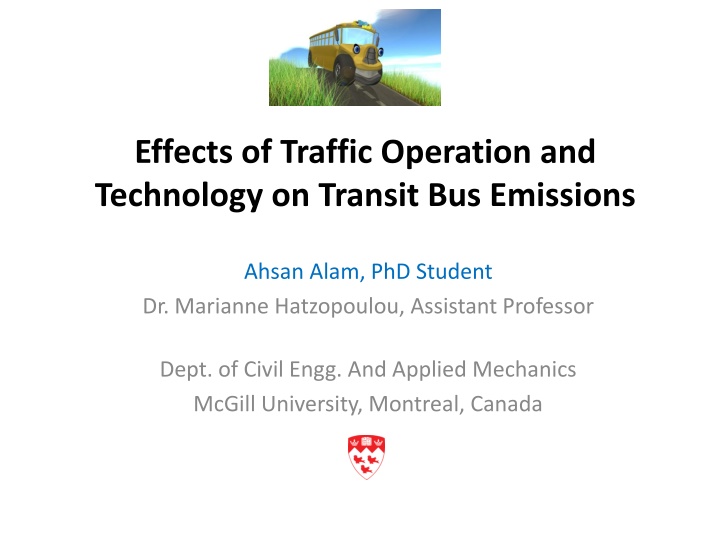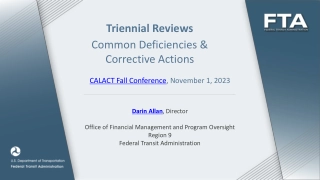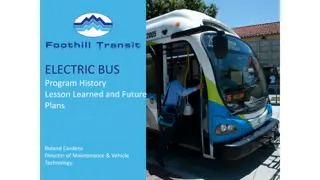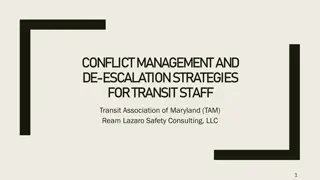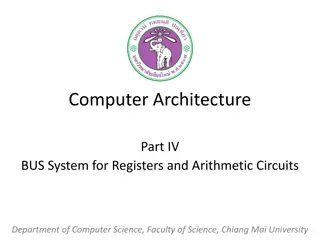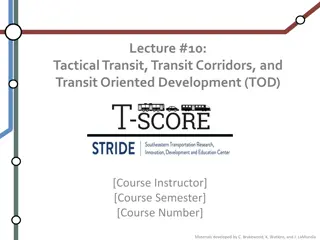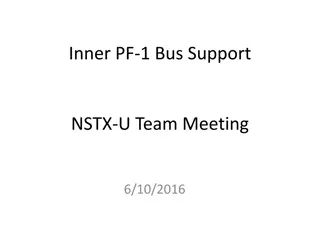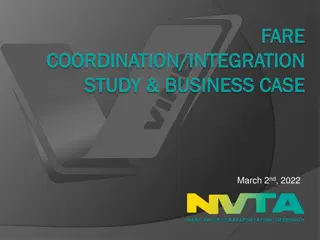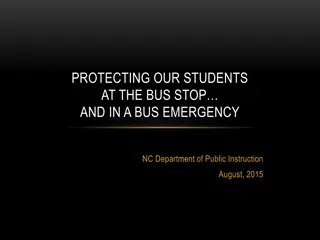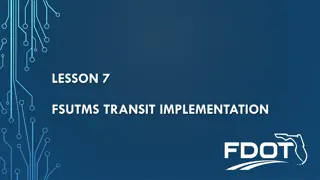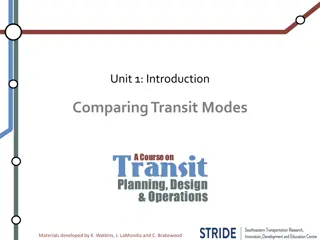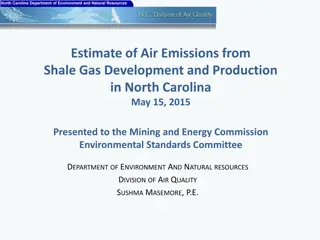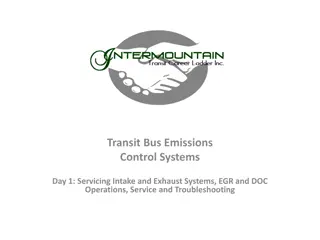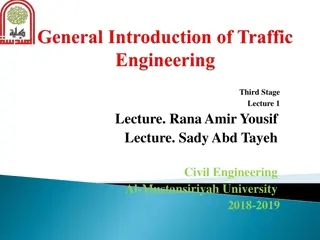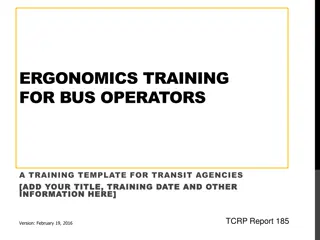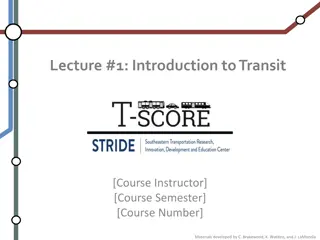Effects of Traffic Operation and Technology on Transit Bus Emissions
This research delves into the impact of traffic operations and technology on transit bus emissions, focusing on reducing emissions through alternative fuels and improving traffic management. The study area is a bus route in Montreal, Canada, where emissions from buses using ultra-low sulfur diesel and compressed natural gas are compared under various traffic operation scenarios. The goal is to simulate and analyze transit emissions along a busy corridor, considering factors like fuel type, traffic signal priority, bus stop relocation, and queue jumper lanes. Through detailed emission modeling and analysis, the research aims to provide insights into reducing the environmental impact of transit operations.
Download Presentation

Please find below an Image/Link to download the presentation.
The content on the website is provided AS IS for your information and personal use only. It may not be sold, licensed, or shared on other websites without obtaining consent from the author.If you encounter any issues during the download, it is possible that the publisher has removed the file from their server.
You are allowed to download the files provided on this website for personal or commercial use, subject to the condition that they are used lawfully. All files are the property of their respective owners.
The content on the website is provided AS IS for your information and personal use only. It may not be sold, licensed, or shared on other websites without obtaining consent from the author.
E N D
Presentation Transcript
Effects of Traffic Operation and Technology on Transit Bus Emissions Ahsan Alam, PhD Student Dr. Marianne Hatzopoulou, Assistant Professor Dept. of Civil Engg. And Applied Mechanics McGill University, Montreal, Canada
Background Transportation benefits us by moving people and goods. More demand, more traffic on road. Result: Traffic congestion Road collisions Environmental pollution 2
Background Environmental effect Global warming: greenhouse gas emissions Transportation is responsible: 23% of total GHG emissions (worldwide) 26% of total GHG emissions (Canada) 74% of transportation emissions: roadway Health effect Respiratory, cardiovascular diseases Premature mortality 3
Motivation Public Transit: Considered environmentally friendly But transit can be as polluting as car (per passenger basis) based on Age Fuel Maintenance Speed Passenger volume 4
Research Question How to reduce transit emissions? 5
Research Question How to reduce transit emissions: By using alternative fuels? or By improving traffic operation? 6
Outline Simulate transit emissions along the busy corridor in Montreal, Canada (PTV VISSIM) Compare the emissions of transit buses (using MOVES) For 2 alternative fuels: o Ultra low sulfur diesel (15 ppm sulfur content) o Compressed natural gas (CNG) Under different traffic operation: o Transit signal priority (TSP) o Relocation of bus stops o Queue jumper lane 7
Study Area 165 Bus Route downtown 8
Base Case Emission Modelling One bus is tracked over an entire route (NB and SB) through links and bus stops Link based emissions: NB: 30 links & SB: 34 links Sec-by-sec speed profile for each link Age distribution: 58.39% are of 2010 model & 41.61% are of 2009 model Fuel: Ultra Low Sulfur Diesel (ULSD) Compressed Natural Gas (CNG) Meteorology: Temperature & Humidity 9
Simulated Bus Speed Profile Variables Length (mile) Number of bus stops Length of longest link (mile) Length of shortest link (km) Total travel time (min) Average journey speed (mph) Maximum speed Time spent (sec) during journey Between 0- 1 mph Between 2-5 mph Between 6-15 mph Between 15-25 mph >25 mph SB 4.74 34 0.3 0.0775 50.03 5.68 28.83 2,579 1,296 301 517 369 96 NB 4.09 30 0.3 0.05 30.10 8.15 27.43 1,228 279 147 336 437 29 11
Base Case Emissions Running Emissions (g/mile) SB NB Diesel CNG Reduction (%) 11.75 84.79 Diesel 2835.85 0.03562 CNG 2608.23 0.00403 Reduction (%) 8.03 88.68 CO2-eq. 3504.17 3092.31 PM2.5 0.04631 0.00704 Dwell Emissions at Bus Stops (g) SB NB Diesel CNG Reduction (%) 21.00 86.28 Diesel 668.93 0.01379 CNG 528.45 0.00189 Reduction (%) 21.00 86.28 CO2-eq 1719.47 1358.38 PM2.5 0.03544 0.00486 12
Base Case Emissions (SB) downtown 13
Base Case Emissions (NB) Changes in CO2eq. EFs Avg. Speed of the NB Bus 14
Scenario Analysis Traffic operation based scenario: 1) Transit signal priority (TSP) 2) Bus-stop relocation 3) TSP+ Bus-stop relocation 4) Queue jumper lane 5) TSP+Bus-stop relocation+Queue jumper lane 15
Scenario Analysis Traffic operation based scenario: 1) Transit signal priority (TSP) 2) Bus-stop relocation 3) TSP+ Bus-stop relocation 4) Queue jumper lane 5) TSP+Bus-stop relocation+Queue jumper lane 16
Scenario Analysis Traffic operation based scenario: 1) Transit signal priority (TSP) 2) Bus-stop relocation 3) TSP+ Bus-stop relocation 4) Queue jumper lane 5) TSP+Bus-stop relocation+Queue jumper lane 17
Scenario Analysis Traffic operation based scenario: 1) Transit signal priority (TSP) 2) Bus-stop relocation 3) TSP+ Bus-stop relocation 4) Queue jumper lane 5) TSP+Bus-stop relocation+Queue jumper lane 18
Scenario Analysis Traffic operation based scenario: 1) Transit signal priority (TSP) 2) Bus-stop relocation 3) TSP+ Bus-stop relocation 4) Queue jumper lane 5) TSP+Bus-stop relocation+Queue jumper lane 19
Scenario Analysis CO2eq (g/mile) for Diesel SB CO2eq (g/mile) for CNG SB Scenario Description NB NB 3504.17 (0%) 2835.85 (0%) 3092.31 (11.75%) 2608.23 (8.03%) Base 3031.62 (13.49%)* 2668.13 (5.91%) 2709.99 (22.66%) 2438.94 (14.00%) Introduction of TSP Relocating bus-stops to mid-block 3191.55 (8.92%) 2849.25 (-0.47%) 2869.31 (18.12%) 2639.98 (6.94%) Introducing TSP and mid-block bus-stop relocation 3062.49 (12.60%) 2776.40 (2.09%) 2770.66 (20.93%) 2548.81 (10.12%) Introducing queue jumper lane 2987.94 (14.73%) 2802.61 (1.17%) 2692.23 (23.17%) 2542.80 (10.33%) Introducing TSP, queue jumper lane and relocating bus-stops to mid-block 2887.56 (17.61%) 2732.60 (3.64%) 2654.13 (24.26%) 2504.10 (11.70%) 20 * Percent reduction in emissions compared to base case
Results Found Switching from diesel to CNG fuel could reduce CO2-eq. emissions by 8 to 12 percent. As the levels of congestion rise, the reduction benefits become higher indicating that the benefit of switching to CNG becomes more apparent under congested conditions. 21
Results Found TSP alone has the ability to reduce emissions significantly for both directions, congested and uncongested. When TSP is combined with other measures reduction is significant only in the congested direction. CNG in combination with operational changes further improves emission reductions. However, many operational changes can achieve better reductions than switching to CNG and maintaining base-case operations. 22
Future Research Plan The effects of varying congestion levels on the performance of traffic operation and technology. To understand the effects of grade and passenger load factor on transit emissions. 23
Present Research Passenger Load Factor (PLF) 0 Grade -7.5% Passenger Load Factor (PLF) 0.5 Grade -5.0% Average speed: 6mph Passenger Load Factor (PLF) 1.0 Grade -2.5% Drive cycle Average speed: 9mph Passenger Load Factor (PLF) 1.5 Grade 0% Passenger Load Factor (PLF) 2.0 Grade 2.5% Average speed: 16mph Grade 5.0% Grade 7.5% 24
Present Research 24000 22000 Total emissions (g) 20000 Avg. speed of 16mph 18000 Box plots Random seeds 16000 14000 12000 10000 8000 6000 4000 -7.5 -5 -2.5 0 2.5 5 7.5 Grade (%) 28000 26000 Avg. speed of 6 mph Total emissions (g) 24000 22000 20000 18000 16000 14000 12000 10000 8000 -7.5 -5 -2.5 0 2.5 5 7.5 Grade (%) 26
Present Research 18000 At zero slope 17000 16000 Total emissions (g) 15000 14000 13000 12000 0 passenger 19 passengers 38 passengers 57 passengers 76 passengers No. of passengers 27
Present Research At zero slope At +7.5% slope 28
Present Research At 7.5% slope 29
Present Research 300 1200 250 1150 200 1100 EF (g/VMT) per passenger Diesel EF(g/VMT) 150 CO2 eq. EF (g/VMT) 1050 Diesel EF(g/VMT/pass.) 100 1000 50 Diesel EF(g/VMT/40 pass.) 0 950 0 0.5 1 1.5 2 2.5 PLF 1= 38 passengers PLF 2 = 75 passengers Passenger Load Factor (PLF) 30
THANK YOU! http://traq-research.mcgill.ca/Students/Students.html ahsan.alam2@mail.mcgill.ca 31
